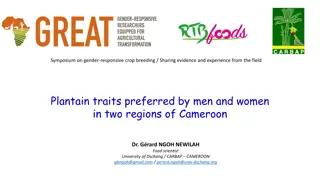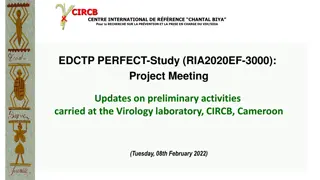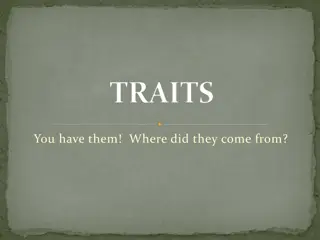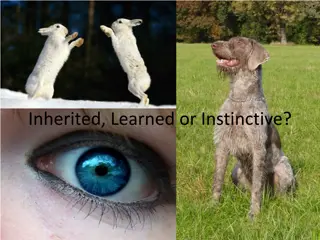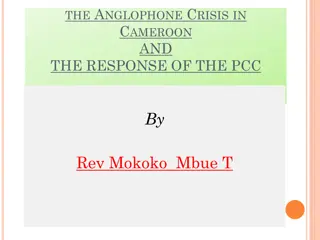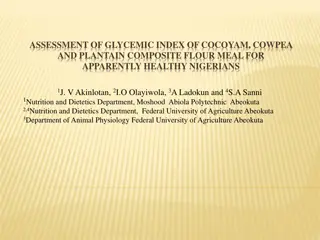Understanding Gender Preferences in Plantain Traits in Cameroon
Plantains play a significant role in Cameroon's agriculture, with 1.9 million tons produced annually. A symposium discusses the importance of studying gender preferences in plantain traits to enhance crop breeding efforts. Research findings reveal insights into men and women's perceptions and decision-making processes regarding plantain cultivation and use, emphasizing the need for gender-responsive approaches in crop development.
Download Presentation

Please find below an Image/Link to download the presentation.
The content on the website is provided AS IS for your information and personal use only. It may not be sold, licensed, or shared on other websites without obtaining consent from the author. Download presentation by click this link. If you encounter any issues during the download, it is possible that the publisher has removed the file from their server.
E N D
Presentation Transcript
Symposium on gender-responsive crop breeding / Sharing evidence and experience from the field Plantain traits preferred by men and women in two regions of Cameroon Dr. G rard NGOH NEWILAH Food scientist University of Dschang / CARBAP CAMEROON gbngoh@gmail.com / gerard.ngoh@univ-dschang.org
Introduction Bananas and plantains: important staple and cash crop in the tropical regions of the world Production in 2018: 139.4 million tons worldwide, with plantains accounting for about 1/7 of their production Cameroon is ranked fourth after Nigeria, Democratic Republic of Congo and Ghana, with an annual production of 1.9 million tons of plantains (Lescot, 2020); Plantain hybrids are still not adopted and hence there is a need to understand how gender influences preferences and prioritization for plantain characteristics.
Methodology Approach : participative survey within the framework of RTBfoods Project Location: eight rural areas of Cameroon 1. West region: Balessing, Penka Michel, Bafounda and Bamendjing 2. Littoral region: Bouba, Sokelle, Song-mayo and Kombe; Main activities: 1. key informant interviews, 2. gender-disaggregated focus group discussions, 3. market and individual interviews
I. Importance of cultivated crops Table 1: Important crops to both genders Crop importance 1st 2nd 3rd 4th 5th Global Men Women Maize Plantain/Cassava Beans Cocoyam Yam Plantain Maize/Cassava Cocoyam Beans Cocoa/Yam Maize Beans/Cassava Plantain Yam/Beans Cocoyam Table 2: Reasons why the crop is important and for who Crop Reasons why the crop is important Persons for whom the crop is important - Source of income and easily sold in the market - Gives much income than any other crop, it is also used as food - High revenue, it is also consumed at home - Highly demanded in the market - Does not finish on the farm, it lasts! - Men - Entire family - Men and women - Children Plantain
II. Decision making on plantain Men have complete independence; Women s dependence is little, they can only suggest ideas Some cases of joint decisions appear Table 3: Mean score of independence in decisions by sex and region Decision Mean score of independence 1-4* Female Male Variety of crop to plant 2.2 3.8 *Legend 1 = no independence the decision is made by someone else 2 = a little independence to suggest ideas, but decision is taken by someone 3 = most independent but need to consult someone 4 = complete independence Use of crop 3.6 1.7 Marketing 2.6 3.7 Use of profit from sale of boiled plantain 0.6 0.0 Use of profit from sale of alternative product 0.0 0.0 Table 4: Frequency of citations of people who make decisions on boiled plantain by gender and region People who make decision (N=78) Gender % of women citing (N=40) % of men citing (N=38) Husbands 2.56 (2) 12.82 (10) Wives 47.44 (37) 35.9 (28) Children 1.28 (1) 0 (0)
III. High quality characteristics of plantain Table 5. High quality characteristics of raw material (% of citations based on weighed ranking) Characteristics Women (n=40) 15.4 19.9 8.1 5.7 23.6 3.3 0.8 8.9 3.7 9.3 0.0 1.2 Men (n=38) 20.2 16.9 15.1 8.8 8.8 5.9 4.8 4.4 4.4 3.3 4.4 2.9 Total (n=78) 18.0 18.3 11.8 7.3 15.8 4.6 2.9 6.6 4.1 6.2 2.3 2.1 Dark green coloured plantain peel Big plantain fruits Presence of a ripe finger Yellow coloured plantain pulp Mature plantain fruits Presence of a split fruit Presence of stains on peel Orange coloured plantain pulp Black-edged fingers Hard plantain fruits Attractive plantain bunch Green coloured plantain peel Values in bold are significantly different at 5% threshold
IV. Low quality characteristics of plantain Table 6. Poor quality characteristics of raw material (% of citations based on weighed ranking) Characteristics Women (n=40) Men (n=38) Total (n=78) Immature plantain bunch 39.6 28.9 34.7 White coloured plantain pulp 22.6 22.2 22.4 Not hard (on touching) 13.2 8.9 11.2 Light green coloured plantain peel 7.5 15.6 11.2 Small plantain fruits 7.5 17.8 12.2 Presence of black spots 3.8 0.0 2.0 Big plantain fruits 1.9 0.0 1.0 Pale green coloured plantain peel 1.9 0.0 1.0 Thin plantain fruits Presence of green leaves (at harvest) 1.9 0.0 0.0 2.2 1.0 1.0 Absence of black edges on plantain fruits 0.0 4.4 2.0 Values in bold are significantly different at 5% threshold
V. Source of planting material and limiting factors of adoption Individuals had more than one source; Sucker prices : between 100 and 250 FCFA per sucker; Source of suckers : 1. gifts from relatives (when they know these suckers will produce good plantain bunches); 2. gifts from Husbands to wive (s). Table 7: Source of planting material Source of planting material* Female (N=40) Male (N=38) Purchased 15 08 Gift 02 03 My farm 29 33 Extension agent 00 01 *Individuals had more than one source
Conclusion Plantain is mainly grown by men; Plantains are processed at household level and in restaurants by women; Plantain bunches are sold by men or by women; High quality plantain characteristics are Dark green coloured plantain peel for men and Mature fruits for women; Low quality plantain is characterized by immature bunch with white colored pulp







